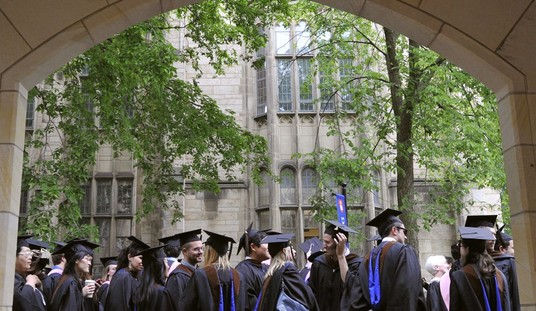The economy took a small step back from its previous quarter, the Commerce Department reported today, with GDP up 3.2% in Q4. Overall, 2013 also took a big step back from 2012, however, even if it appears that the momentum may have shifted a bit toward the end of the year. The advance estimate of fourth-quarter growth dropped a bit from Q3’s 4.1%, but the inventory expansion factor lessened considerably as well:
Real gross domestic product — the output of goods and services produced by labor and property located in the United States — increased at an annual rate of 3.2 percent in the fourth quarter of 2013 (that is, from the third quarter to the fourth quarter), according to the “advance” estimate released by the Bureau of Economic Analysis. In the third quarter, real GDP increased 4.1 percent.
The Bureau emphasized that the fourth-quarter advance estimate released today is based on source data that are incomplete or subject to further revision by the source agency (see the box on page 4 and “Comparisons of Revisions to GDP” on page 5). The “second” estimate for the fourth quarter, based on more complete data, will be released on February 28, 2014.
The increase in real GDP in the fourth quarter primarily reflected positive contributions from personal consumption expenditures (PCE), exports, nonresidential fixed investment, private inventory investment, and state and local government spending that were partly offset by negative contributions from federal government spending and residential fixed investment. Imports, which are a subtraction in the calculation of GDP, increased.
The deceleration in real GDP in the fourth quarter reflected a deceleration in private inventory investment, a larger decrease in federal government spending, a downturn in residential fixed investment, and decelerations in state and local government spending and in nonresidential fixed investment that were partly offset by accelerations in exports and in PCE and a deceleration in imports.
Year on year, the story looks more grim:
Real GDP increased 1.9 percent in 2013 (that is, from the 2012 annual level to the 2013 annual level), compared with an increase of 2.8 percent in 2012.
We lost significant ground again, in an economy that’s supposed to be recovering. This throws a big dash of cold water on Obama’s State of the Union bragging about his economic policies.
In one sense, though, the news is relatively good, especially after December’s durable-goods report showed a significant decline. It’s not entirely clear whether that got into the advance report, by the way, as the Q4 report shows a 5.9% over the entire quarter. The advance report uses estimates on several of these measures, and we’ll see in the interim report whether this figure drops.
The good news is that overall growth is still in the 3% range, where we have rarely been in this “recovery” since it began in June 2009. Real growth actually increased from Q3, too, as measured in real final sales of domestic product — the metric that strips out inventory expansion. That grew at a 2.8% annualized rate, better than Q3’s 2.5%. The gap between inventory expansion in the two quarters might be a bit of a warning shot, though, on the outlook from producers and wholesalers on the direction of the economy.
On the other hand, consumer activity looks worrisome:
Real gross domestic purchases — purchases by U.S. residents of goods and services wherever produced — increased 1.8 percent in the fourth quarter, compared with an increase of 3.9 percent in the third.
Personal consumption expenditures rose 2.3% year-on-year for Q4. That’s the best all year, but that’s not a great result from the holiday season. Personal outlays kept pace with Q3, though, while the personal saving rate dropped from 4.9% to 4.3%.
Reuters put an uncharacteristically gloomy cast on the report in its headline, thanks in part to a small rise in weekly initial unemployment claims, but were cheerier on the actual data:
The number of Americans filing new claims for unemployment benefits rose more than expected last week, but the underlying trend suggested the labor market continued to heal.
Initial claims for state unemployment benefits increased 19,000 to a seasonally adjusted 348,000, the Labor Department said on Thursday. Claims for the prior week were revised to show 3,000 more applications received than previously reported. …
Gross domestic product grew at a 3.2 percent annual rate, the Commerce Department said, in line with expectations. While that was a slowdown from the third-quarter’s brisk 4.1 percent pace, it was a far stronger performance than earlieranticipated and was welcome news in light of a 0.3 percentage point drag from October’s partial government shutdown and a much smaller contribution to growth from a restocking by businesses.
Earlier in the quarter many economists were anticipating a growth pace below 2 percent given that an inventory surge accounted for much of the increase in the July-September period. Growth over the second half of the year come in at a 3.7percent pace, up sharply from 1.8 percent in the first six months of the year. It was the biggest half-year increase since the second half of 2003.
Overall, the quarter result isn’t too bad. The 2013 result shows that we should wait to break out the bubbly.








Join the conversation as a VIP Member